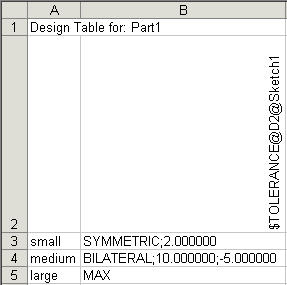Manual Method
In the Dimension PropertyManager, when you specify a tolerance, you can assign it to This configuration, All configurations, or Specify configurations.
Design Table
In a design table, you can control tolerances as follows:
- In a part document, you can control the tolerances on dimensions in sketches and in feature definitions.
- In an assembly document, you can control the tolerances on dimensions that belong to assembly features. This includes mates (angle or distance), assembly feature cuts and holes, and component pattern spacing. You cannot control the tolerances on dimensions of a component contained in the assembly.
The column header in a design table for controlling tolerances uses this syntax:
$TOLERANCE@Dimension
For example, the tolerance on the depth of an extrude feature is $TOLERANCE@D1@Extrude1; the tolerance on a distance mate is $TOLERANCE@D1@Distance1.
The column header is not case sensitive.
In the table body cells, type the value for the tolerance, using a valid keyword and syntax. If a cell is left blank, the dimension has no tolerance. For a derived configuration, if a cell is left blank, the component uses the tolerance value of its parent.
When you specify values, be sure to use the system of units specified for the model in .
Example of a design table that controls a tolerance:

Tolerance Keywords and Syntax in Design Tables
When entering values for tolerances in a design table, use the following keywords, in the syntax shown.
| NONE |
| BASIC |
| MIN |
| MAX |
| BILATERAL;max_variation;min_variation
|
| LIMIT;max_variation;min_variation
|
| SYMMETRIC;max_variation |
| FIT;class;hole_fit;shaft_fit;type_fit;max_variation;min_variation
|
| FIT_WITH_TOLERANCE;class;hole_fit;shaft_fit;type;max_variation;min_variation
|
| FIT_TOLERANCE_ONLY;class;hole_fit;shaft_fit;type;max_variation;min_variation |
where:
| max_variation is the positive tolerance.
|
| min_variation is the negative tolerance.
|
| class is the general classification. Valid values: USER_DEFINED, CLEARANCE, TRANSITIONAL, PRESS.
|
| hole_fit is the hole fit class. Examples: A9, H12, ZC11, and so on.
|
| shaft_fit is the shaft fit class. Examples: a9, h12, zc11, and so on.
|
| type is the type of fit. Valid values: HOLEFIT, SHAFTFIT.
|
If a cell is left blank, the tolerance value is NONE.
For a derived configuration, if a cell is left blank, the component uses the tolerance value of its parent.